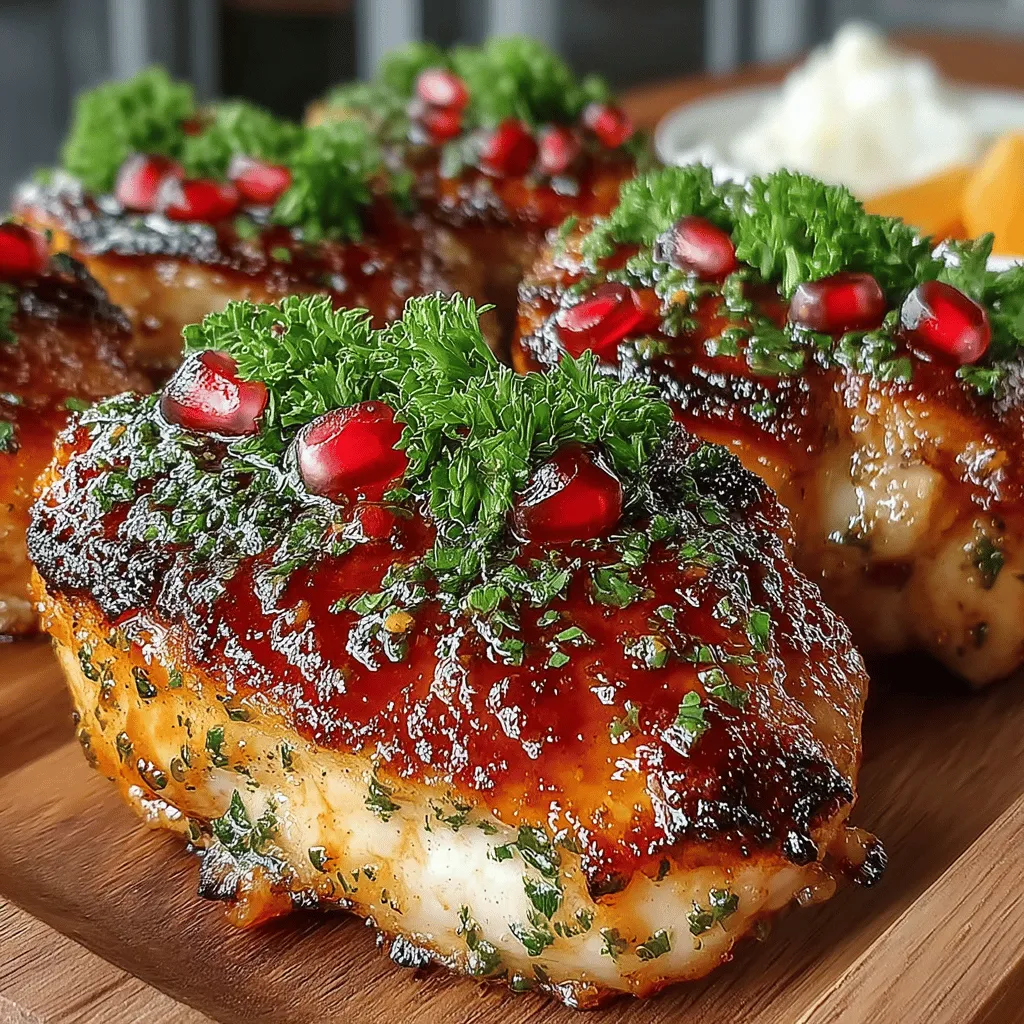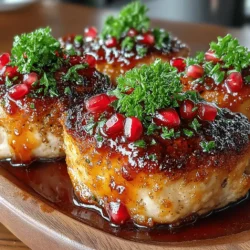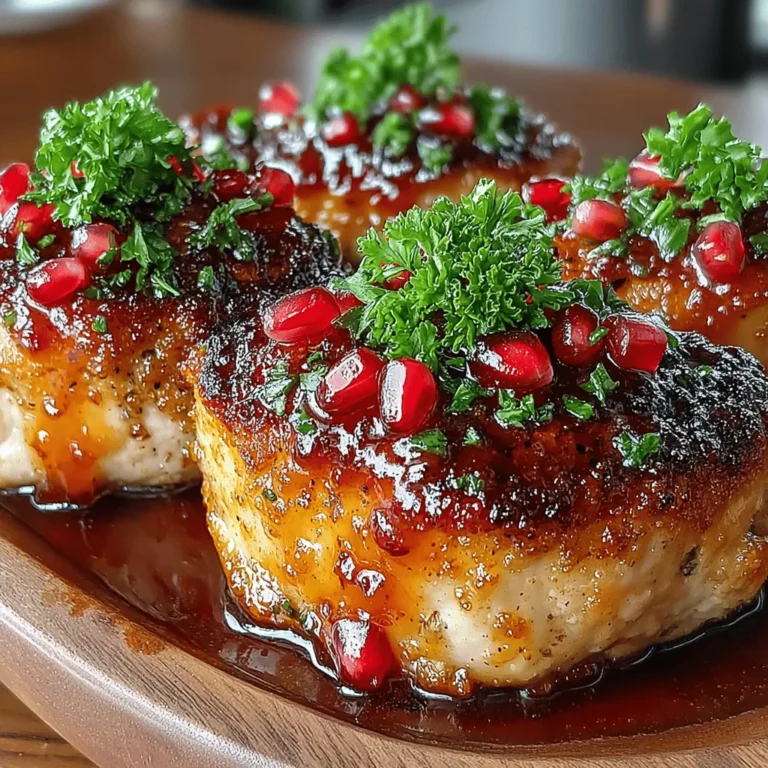Introduction to Pomegranate Glazed Chicken
Pomegranate Glazed Chicken is a culinary gem that beautifully combines sweet, tangy, and savory flavors, creating a dish that is both visually stunning and deliciously satisfying. This recipe not only elevates the everyday dinner experience but also brings a touch of sophistication to special occasions, making it a versatile addition to any meal repertoire. Imagine juicy chicken breasts coated in a glossy pomegranate glaze, their vibrant color capturing the eye and enticing the palate. This dish is not just a feast for the senses; it’s also straightforward to prepare, making it perfect for busy weeknights or casual gatherings with friends and family.
The beauty of Pomegranate Glazed Chicken lies in its simplicity. The ingredients used in this recipe are easily accessible, and the preparation steps are uncomplicated, allowing even novice cooks to create a restaurant-quality dish at home. As we dive deeper into this article, we will explore the essential ingredients that make up this delicious glaze and provide a step-by-step guide to preparing this delightful meal. Whether you’re looking to impress guests or treat your family to something special, Pomegranate Glazed Chicken is sure to leave everyone craving more.
Understanding the Ingredients
To create a memorable Pomegranate Glazed Chicken, understanding the role of each ingredient is crucial. This dish relies on a harmonious blend of flavors that come together to create a glaze that complements the chicken perfectly. Let’s take a closer look at the key ingredients that make this recipe shine.
Exploring Chicken Breasts as the Main Protein
At the heart of this recipe are boneless, skinless chicken breasts. This choice of protein is not only popular but also offers several advantages. Chicken breasts are lean, making them a healthy option rich in protein while remaining low in fat. Their mild flavor allows them to absorb the delicious pomegranate glaze effectively, ensuring that every bite is bursting with flavor.
For those seeking alternative protein options, consider using chicken thighs, which offer a bit more fat and can provide a richer taste. If you prefer a non-poultry option, turkey breasts or even plant-based proteins like tofu can work well in this recipe, although the cooking times may need adjustment to achieve the desired doneness.
The Role of Pomegranate Juice in the Glaze
Pomegranate juice is the star of the show when it comes to the glaze. This vibrant juice is not just visually appealing; it also brings a wealth of nutritional benefits. Rich in antioxidants, vitamins, and minerals, pomegranate juice is known for its anti-inflammatory properties and potential heart health benefits.
In terms of flavor, pomegranate juice adds a unique sweet-tart profile that enhances the overall taste of the dish. Its deep red color contributes to the visual appeal, giving the chicken an enticing glaze that makes it a centerpiece on any dinner table.
Honey: The Sweet Element
Honey plays a pivotal role in balancing the flavors of the glaze. Its natural sweetness complements the tartness of the pomegranate juice, creating a harmonious blend that enhances the overall taste experience. Additionally, honey helps to thicken the glaze, ensuring that it clings beautifully to the chicken as it cooks.
For those looking for alternatives, maple syrup can serve as a suitable substitute for honey, providing a similar sweetness with a unique flavor twist. Agave nectar or brown sugar can also be used, though they may alter the glaze’s final consistency slightly.
Soy Sauce: Adding Umami
Soy sauce is another essential ingredient that introduces a depth of flavor to the glaze through its umami richness. It enhances the savory notes of the chicken, creating a well-rounded flavor profile. The saltiness of soy sauce also helps to balance the sweetness of the honey and pomegranate juice, making it a key component of this recipe.
For individuals avoiding soy, tamari or coconut aminos can be excellent alternatives that retain the umami flavor without the potential allergens commonly found in traditional soy sauce.
Apple Cider Vinegar: A Tangy Kick
Adding apple cider vinegar to the glaze introduces a tangy kick that brightens the overall flavor. Its acidity helps to cut through the sweetness, providing a balanced taste that keeps the dish from becoming overly rich. Furthermore, apple cider vinegar is known for its health benefits, including aiding digestion and supporting weight management.
If apple cider vinegar is unavailable, other vinegar options such as rice vinegar or balsamic vinegar can be used, though they may impart different flavor nuances to the glaze.
Garlic and Ginger: Aromatic Essentials
Garlic and ginger are aromatic ingredients that elevate the flavor profile of Pomegranate Glazed Chicken. Garlic brings a savory richness, while ginger adds a warm, spicy note that complements the sweetness of the glaze. Together, they create a well-rounded flavor base that enhances the dish’s complexity.
To ensure the best flavor, it’s important to prepare garlic and ginger properly. Freshly minced garlic and grated ginger work best, as they release essential oils and flavors that dried or powdered forms may lack.
Optional Heat: The Role of Red Pepper Flakes
For those who enjoy a bit of spice, red pepper flakes can be added to the glaze to provide a subtle heat that contrasts beautifully with the sweetness of the pomegranate. The amount can be adjusted according to personal preference; a pinch will add warmth without overwhelming the dish, while more can create a noticeable kick.
If red pepper flakes aren’t available, consider other options for adding heat, such as fresh chili peppers or hot sauce, allowing you to customize the dish to your taste.
Step-by-Step Instructions for Pomegranate Glazed Chicken
Now that we’ve explored the ingredients that come together to create this vibrant dish, let’s dive into the step-by-step instructions for preparing Pomegranate Glazed Chicken. This easy-to-follow guide will walk you through the process, ensuring that you achieve a perfectly glazed chicken every time.
1. Gather Your Ingredients: Start by assembling all the necessary ingredients. You’ll need boneless, skinless chicken breasts, pomegranate juice, honey, soy sauce, apple cider vinegar, garlic, ginger, and red pepper flakes (if desired).
2. Prepare the Marinade: In a mixing bowl, combine pomegranate juice, honey, soy sauce, apple cider vinegar, minced garlic, grated ginger, and red pepper flakes. Whisk together until well blended. This marinade will serve as both a flavor booster and a glaze for your chicken.
3. Marinate the Chicken: Place the chicken breasts in a resealable plastic bag or a shallow dish. Pour the marinade over the chicken, ensuring that each piece is thoroughly coated. Seal the bag or cover the dish and refrigerate for at least 30 minutes, allowing the flavors to penetrate the meat. For optimal flavor, marinate for up to 2 hours.
4. Preheat the Oven or Grill: Depending on your cooking method of choice, preheat your oven to 400°F or prepare a grill for medium-high heat. If using an oven, line a baking sheet with parchment paper for easy cleanup.
5. Cook the Chicken: Remove the chicken from the marinade, allowing any excess liquid to drip off. Place the chicken breasts on the prepared baking sheet or grill. If baking, cook for about 20-25 minutes, or until the chicken reaches an internal temperature of 165°F. If grilling, cook for about 6-7 minutes per side, basting with reserved marinade for added flavor.
As we continue, we will delve further into the finishing touches and presentation tips that will make your Pomegranate Glazed Chicken a stunning centerpiece for your dining experience. Stay tuned for the next part of this article, where we will discuss serving suggestions and storage options to ensure that your culinary creation remains as delicious as it is visually appealing.

Preparing the Chicken Breasts for Cooking
Importance of Seasoning and Its Impact on Flavor
Seasoning is a critical step in preparing your chicken breasts for the Pomegranate Glazed Chicken recipe. Properly seasoned chicken enhances the overall flavor profile of the dish, making each bite more enjoyable. Start by generously seasoning both sides of the chicken breasts with salt and pepper. This fundamental seasoning not only elevates the natural flavors of the chicken but also serves to create a delicious crust when seared.
For an extra layer of flavor, consider marinating the chicken breasts in a mixture of olive oil, crushed garlic, and herbs like thyme or rosemary for at least 30 minutes before cooking. This marination process allows the chicken to absorb and retain moisture, resulting in a juicier final product.
Tips for Ensuring Even Cooking
Achieving evenly cooked chicken breasts is essential to ensure that each piece is tender and juicy. Here are a few tips to help you with this:
1. Uniform Thickness: Use a meat mallet to pound the chicken breasts to an even thickness. This ensures that the chicken cooks uniformly, preventing the thinner parts from drying out.
2. Room Temperature: Allow your chicken breasts to come to room temperature for about 15-20 minutes before cooking. This helps in achieving a more consistent cooking temperature throughout the meat.
3. Use a Meat Thermometer: For best results, utilize a meat thermometer to check the internal temperature of the chicken. The USDA recommends that chicken should reach an internal temperature of 165°F (75°C) to be safe for consumption.
Searing the Chicken: Achieving the Perfect Crust
Techniques for Effective Searing
Searing is a crucial technique that enhances the flavor and texture of your chicken. To achieve the perfect crust:
1. Preheat Your Pan: Heat a skillet over medium-high heat and add a tablespoon of oil, such as olive oil or avocado oil. The oil should shimmer but not smoke, indicating that the pan is hot enough for searing.
2. Avoid Overcrowding: Cook the chicken in batches if necessary. Overcrowding the pan lowers the temperature and prevents proper browning.
3. Don’t Move the Chicken: Once the chicken is in the pan, resist the urge to move it around. Allow it to sear undisturbed for about 5-7 minutes on one side until it develops a golden-brown crust before flipping.
Why Resting the Chicken is Crucial
After searing, it is essential to let the chicken rest for about 5-10 minutes. Resting allows the juices to redistribute throughout the meat, resulting in a more succulent chicken. Cutting into the chicken too soon can cause the flavorful juices to run out, leading to dry meat.
Creating the Pomegranate Glaze
The Process of Sautéing Garlic and Ginger for Aroma
To create the delectable pomegranate glaze, start by sautéing minced garlic and ginger in the same skillet used for the chicken. The residual oil and fond (the brown bits left in the pan) will infuse the glaze with rich flavors. Heat the skillet over medium heat and add the minced garlic and ginger, stirring frequently for about 1-2 minutes until fragrant. Be careful not to burn them, as this can introduce a bitter taste to the glaze.
Importance of Simmering to Achieve the Right Consistency
Next, add pomegranate juice, honey, and a splash of soy sauce or balsamic vinegar to the pan. Bring the mixture to a simmer, allowing it to reduce for about 10-15 minutes. This simmering process is essential as it thickens the glaze and concentrates the flavors. You’ll know it’s ready when the sauce coats the back of a spoon and has a glossy appearance.
Glazing the Chicken: The Final Steps
Techniques for Evenly Coating the Chicken
Once the glaze has reached the desired consistency, it’s time to coat the chicken. Place the seared chicken breasts back into the skillet with the pomegranate glaze. Use a spoon or spatula to generously coat each piece with the glaze, ensuring each breast is evenly covered.
To maximize flavor, allow the chicken to simmer in the glaze for an additional 2-3 minutes, turning occasionally. This step not only enhances the flavor but also creates a beautiful, sticky coating on the chicken.
How to Know When the Chicken is Fully Glazed
You’ll know the chicken is fully glazed when it has absorbed the rich flavors of the pomegranate sauce and is beautifully caramelized. The chicken should have a shiny appearance and a slightly sticky texture. Again, ensure the internal temperature reads 165°F (75°C) before serving.
Serving Suggestions and Presentation
Plating the Pomegranate Glazed Chicken
Presentation plays a vital role in the overall dining experience. Here are some tips for plating your Pomegranate Glazed Chicken:
1. Use a White Plate: A simple white plate allows the vibrant colors of the dish to shine through and creates an appealing contrast.
2. Arrange with Care: Place the chicken breasts slightly overlapping on one side of the plate. Drizzle some extra glaze over the top for added shine and flavor.
3. Add Color: Incorporate a side of sautéed green vegetables, such as asparagus or green beans, to add a pop of color and freshness to the plate.
The Impact of Garnishes on Visual Appeal
Garnishing your dish can elevate its presentation dramatically. Consider topping your Pomegranate Glazed Chicken with pomegranate seeds and freshly chopped herbs, such as parsley or cilantro. These garnishes not only enhance visual appeal but also add a burst of freshness and texture to each bite.
Pairing Suggestions for a Complete Meal
Recommended Side Dishes that Complement the Chicken
To create a well-rounded meal, consider pairing your Pomegranate Glazed Chicken with:
– Quinoa Pilaf: A fluffy quinoa pilaf with almonds and dried fruits will complement the sweet and tangy flavors of the chicken perfectly.
– Roasted Vegetables: Seasonal roasted vegetables, such as carrots, bell peppers, and zucchini, will add color and a hearty touch to your plate.
– Couscous Salad: A light couscous salad with cucumbers, tomatoes, and a lemon vinaigrette will provide a refreshing contrast to the richness of the chicken.
Beverage Pairings that Enhance the Dining Experience
For beverage pairings, consider serving a light-bodied red wine, such as Pinot Noir or a crisp white wine like Sauvignon Blanc. Both options will enhance the flavors of the pomegranate glaze. For a non-alcoholic option, a sparkling water with a splash of pomegranate juice can provide a refreshing accompaniment.
Nutritional Information and Dietary Considerations
Understanding the Nutritional Profile of Pomegranate Glazed Chicken
Pomegranate Glazed Chicken is not only delicious but also nutritious. Here’s a breakdown of the nutritional profile per serving:
– Calories: Approximately 320 calories
– Protein: 30 grams
– Fats: 10 grams
– Carbohydrates: 25 grams
This dish is a great source of lean protein while also incorporating the antioxidant-rich benefits of pomegranate juice.
Dietary Considerations for Various Eating Plans
For those following specific dietary plans, Pomegranate Glazed Chicken can easily be adapted:
– Gluten-Free: Ensure that the soy sauce is gluten-free or substitute with tamari.
– Low-Carb: Serve the chicken with a side of steamed broccoli or cauliflower rice instead of grains.
Conclusion: The Joy of Cooking Pomegranate Glazed Chicken
Pomegranate Glazed Chicken is more than just a meal; it is an experience that combines health benefits with gourmet flavor. This dish is a testament to the beauty of simple ingredients coming together to create something extraordinary. Whether you’re entertaining guests or enjoying a quiet family dinner, this recipe is sure to leave a lasting impression. Embrace the art of cooking with this delightful chicken recipe, and savor the flavors that pomegranate brings to your table.
So, roll up your sleeves, gather your ingredients, and embark on a culinary adventure that will fill your home with tantalizing aromas and your hearts with joy. Bon appétit!


